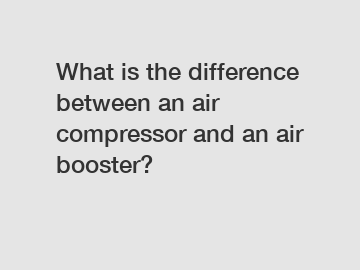Feb. 02, 2024
Tools
What is the difference between an air compressor and an air booster?
An air compressor and an air booster are both devices used to increase the pressure of air. However, there are significant differences between the two in terms of their design, functionality, and applications.
An air compressor is a machine that compresses air to a higher pressure than the surrounding atmospheric pressure. It works by drawing in ambient air, compressing it through a piston or a rotating screw, and then storing it in a tank for later use. The compressed air can be used for various applications, such as powering pneumatic tools, inflating tires, or operating machinery.

On the other hand, an air booster is a device that amplifies the pressure of already compressed air. It takes in the compressed air from an external source and further intensifies the pressure before delivering it to the desired application. Unlike an air compressor, an air booster does not have the mechanism to generate its own compressed air. Instead, it relies on an external compressed air source, such as an existing air compressor or a high-pressure air reservoir.
The key difference between an air compressor and an air booster lies in their primary function and the pressure ratios they can achieve. While an air compressor is designed to create compressed air from atmospheric pressure, an air booster builds upon pre-existing compressed air. This fundamental distinction stems from their respective applications. .
An air compressor is typically used in situations where high-pressure air is required for extended periods, such as in industrial processes or construction work. It provides a continuous source of compressed air that can be regulated and stored for future use. The process of compressing air involves energy consumption and might require additional filters and moisture separators to ensure the quality of the compressed air.
In contrast, an air booster is often employed in situations where the available compressed air pressure is insufficient to meet specific requirements. By amplifying the pressure of pre-compressed air, an air booster can overcome the limitations of the existing compressed air source. This is particularly useful in industries that demand higher-pressure air for specific applications, such as oil and gas, aerospace, and automotive sectors.
The use of air boosters comes with several advantages. Firstly, it enables increased productivity and efficiency by providing a higher-pressure air supply without the need for upgrading the entire compressed air system. Secondly, it allows for better control and regulation of the air pressure, as the booster can be adjusted according to the requirements of the application. Moreover, air boosters can minimize energy consumption by utilizing pre-existing compressed air instead of generating it from scratch, resulting in cost savings and reduced environmental impact.
In conclusion, while both an air compressor and an air booster serve the purpose of increasing air pressure, they differ in terms of their functionality, design, and applications. An air compressor generates its own compressed air, while an air booster amplifies the pressure of pre-existing compressed air. Understanding these differences is essential to select the appropriate device for specific industrial or commercial requirements, ensuring efficient and reliable operation.
Are you interested in learning more about air booster systems, n2 booster compressor, air tank pump? Contact us today to secure an expert consultation!
Previous: Discover the Superiority of Brass Hand Tools: Ultimate Durability and Precision
Next: Master Sheet Bending Techniques and Transform Metal with Ease
If you are interested in sending in a Guest Blogger Submission,welcome to write for us!
All Comments ( 0 )